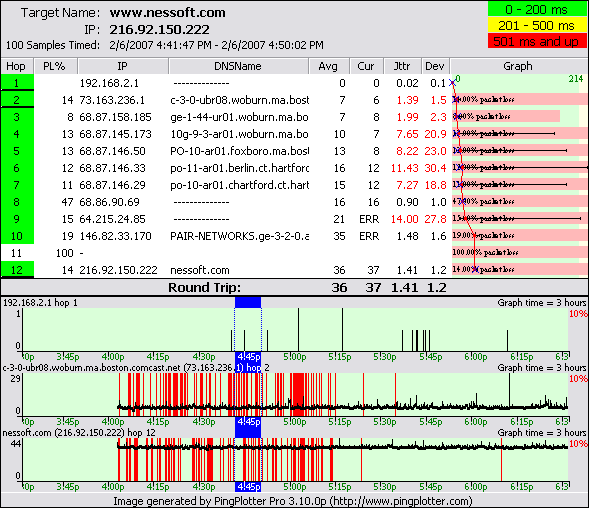

When interpreting network performance data, keep in mind the final hop must be effected for anything else to matter. Internet protocols are designed to correct some amount of packet loss, but anything over 2% usually effects network performance in a negative way. More information about this topic and examples are available in the PingPlotter Knowledge Base. If you feel like getting fancy with expected latency estimations, try controlling for travel time by subtracting speed of light * distance from latency. With this in mind, the location of target servers should be taken into account when deciding whether or not your network experiences unacceptable latency. Like other travel related measurements, latency is affected by the distance separating points A and B. 2: Track the problem back to its origin when the final hop is effected Distance increases latency With a desktop and mobile version at your disposal, you can pinpoint network problems anywhere, anytime. No packet loss happened from within my own network as far as i could see. I let PingPlotter run for a bit in the background (ping to ping-eu.ds.on.) and saw that the packet loss happened at an IP address that belongs to my ISP and another point at an Amazon datacenter. Latency, packet loss, and connection jitter are graphed over time for each hop in the route between the device and any destination you set.
#Pingplotter troubleshooting packet loss problems download#
Better correlation creates better evidence for your case, and we dive a little deeper into this concept in our Pinpointing the Problem article.Į.G. Our best in class graphical traceroute and ping tools go wherever your network needs you. This only happens on my upload, download has 0 packetloss. PingPlotter tests and monitors the connections between you and your ISP, giving you insight into their live status. Maybe you see output like this when you upload a large file. Packet Loss and Packet Burst have been a continuous problem for Call of Duty: Warzone players, so here are some. The case for a problem is further strengthened when you can correlate data with some event. You can scrub through days’ worth of data in an instant to find incidents and diagnose issues.

When bad performance starts somewhere in the route and carries through to the final destination it suggests the problem begins with the first hop showing bad performance. Insights is PingPlotter’s network troubleshooting assistant that looks at your trace results and identifies where (and in some cases, what) problems are impacting a device’s connection. Patterns like this are what you should be looking for. Here we can trace poor performance all the way back to hop 4. This is your cue to inspect the rest of the route. Wanted to try to trace the route to google but something about the. Been having issues for ages with the internet here, seems like Im having 100 packet loss at times. In example 2, we see high packet loss and latency at the final destination. Been having problems with the internet at work recently, trying to get pingplotter to show all the traces but only shows the final one. 1: Ignore packet loss that does not continue to the final hop Consider other hops after destination hop issues are discovered Other possible causes for this are described in the PingPlotter Knowledge Base, but the most important takeaway here is this type of information does not indicate a problem.Į.G. We can ignore patterns like this.Ī common cause of non-continuing packet loss is a router with low priority for timed out ICMP requests (ICMP requests where the TTL equals 0 after reaching them). In example 1, we see scary looking packet loss early in the route, but performance looks good at the final destination. If the final hop is showing 0% packet loss and acceptable latency, you can ignore whatever you see in the hops leading up to it. Learn how well PingPlotter Cloud can quickly troubleshoot and help the user get back up and running fast PingPlotter Cloud has sponsored this post. For example, if 91 of 100 packets reach their destination the network experienced 9% packet loss. Packet loss, latency, and limited bandwidth combine to create a poor experience for both the end-user and the network technician. When packets of data fail to reach their destination, your network is experiencing packet loss. Network latency is a measurement of round trip time (RTT) for a packet of data, or the number of milliseconds it takes a packet to travel to a destination (server) and back again. In case you're unfamiliar with these metrics, we'll start with some basic definitions and expand from there. Following the interpretation guidelines described here helps ensure you're chasing the right problems. If you don't know what you're looking for, it's easy to be mislead by latency and packet loss data.


 0 kommentar(er)
0 kommentar(er)
